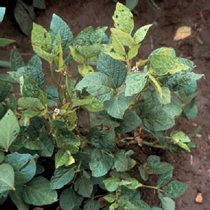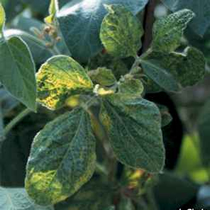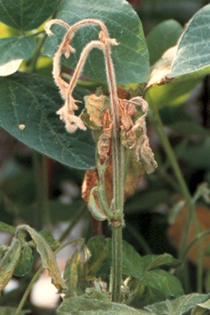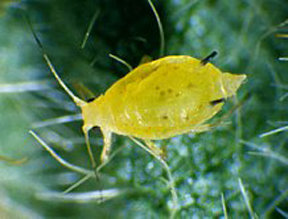By Loren J. Giesler, Former Extension Plant Pathologist
Pathogen
Soybean mosaic is caused by the potyvirus Soybean mosaic virus. SMV is much more studied than bean pod mottle virus. In Nebraska, SMV is not as common as BPMV based on field surveys conducted from the 2000 to 2002 growing seasons, as only 3.5% of fields sampled had SMV.

SMV is transmitted by aphid species and seed. In most varieties seed transmission is less than 5%, but much greater than seed transmission for BPMV. Yield losses due to SMV generally range from 8% to 35%, however losses as high as 94% have been reported. This disease also can be spread through soybean aphids which can vector this virus. SMV infection will reduce oil content, seed germination, and seed quality due to seed coat mottling.
Disease Symptoms
Symptoms of SMV vary with variety, virus strain, environment, and age of plant at infection. Most varieties will be stunted and have fewer pods. Trifoliate leaves will have a mosaic of light and dark green areas that may become blistered or raised with time. Leaves may appear distorted, generally with the leaf margins curling downward. Symptoms are most severe during cool weather and infection is rarely evident during Nebraska summers. The length of time between infection and appearance of symptoms also varies with temperature. Seed from infected plants can be mottled black or brown depending on hilum color. Not all infected plants produce mottled seed and seed mottling does not indicate that the virus in present in the seed.
SMV and BPMV act synergistically. This means that mixed infections are more severe than single infections. Symptoms on plants with both viruses are very severe and terminal death may occur. Yield losses associated with combined infection can be as high as 66 - 86%. The combined infection also increases the level of seed transmission of SMV. Of course, this combination effect is also related to age of the plant when infection occurs.


Favorable Environmental Conditions
Symptoms most pronounced during cool weather and disappear during hot weather. Planting bin run seed from infected fields can increase this problem. The virus is transmitted by aphids and also seed-borne at a rate less than 5% in most varieties. Environmental conditions favoring aphid reproduction can favor this disease if the virus is present to be spread.

Management
Genetic Resistance
Three genes resistant to soybean mosaic virus have been identified, but they are not affective against all strains of the virus. There are currently nine strains of the virus known to occur in the U.S. at this time and the strains that occur in Nebraska are not known.
Cultural Practices
Management of SMV is based on the use of virus free seed and avoiding late planting of soybean to minimize aphid transmission. So far, neither seed transmission nor aphid levels have been sufficient to cause epidemics in Nebraska
Vector Management
NebGuide: Soybean Aphid Management In Nebraska (G2063)
Additional Resources
- North Central Soybean Research and Information Initiative: Soybean Mosaic Virus
Soybean Diseases
- Soybean Diseases (Home)
- Anthracnose
- Bacterial Blight
- Bacterial Pustule
- Bean Pod Mottle Virus
- Brown Spot
- Brown Stem Rot
- Charcoal Rot
- Frogeye Leaf Spot
- Phytophthora Root and Stem Rot
- Pod and Stem Blight
- Purple Seed Stain
- Rhizoctonia Root Rot
- Sclerotinia Stem Rot
- Soybean Cyst Nematode (SCN)
- Soybean Mosaic Virus
- Soybean Rust
- Stem Canker
- Sudden Death Syndrome (SDS)








